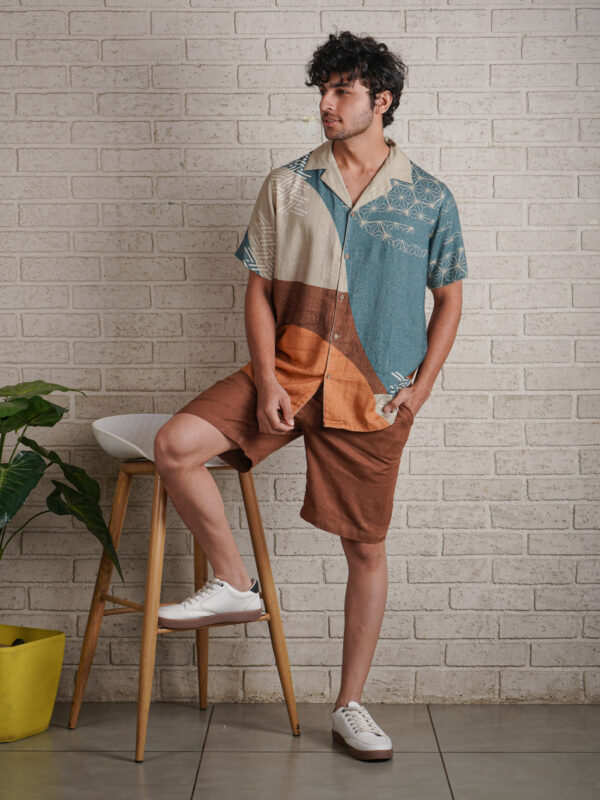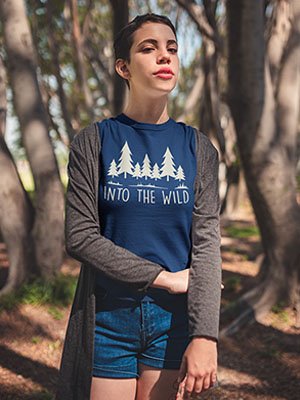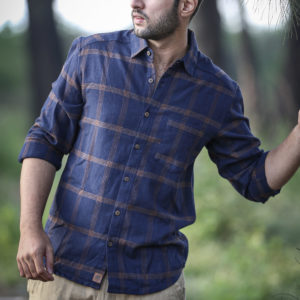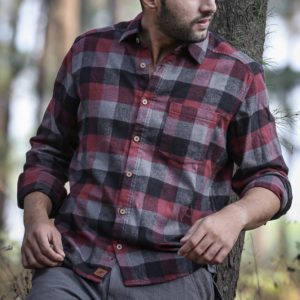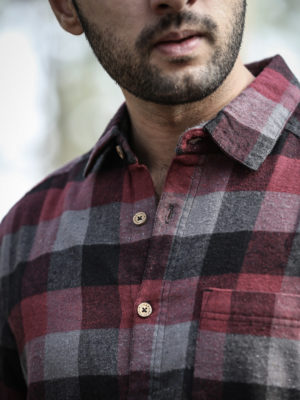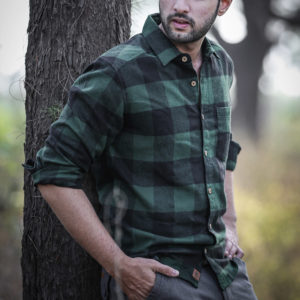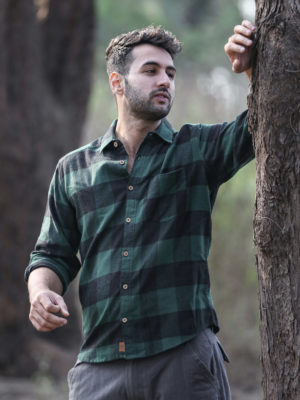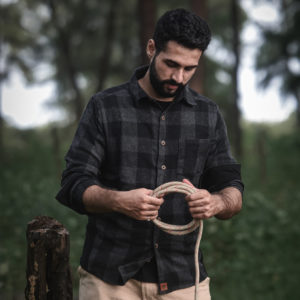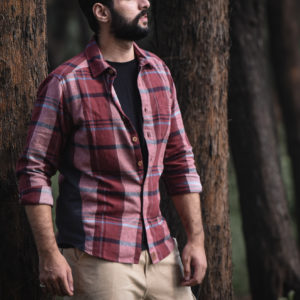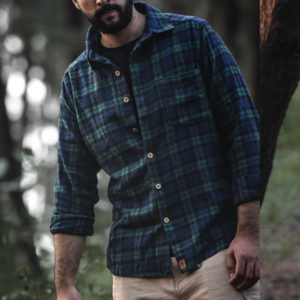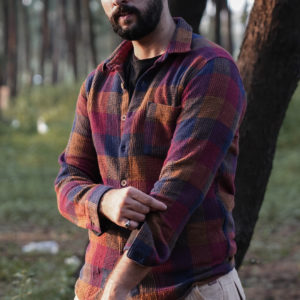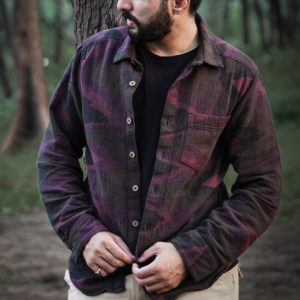1. What is a flannel shirt used for?
A flannel shirt is a versatile and cozy garment that has become a wardrobe staple for both men and women. Originally used as a rugged workwear item for laborers and outdoorsmen, flannel shirts have evolved into a trendy and fashionable choice for casual and outdoor wear.
Flannel shirts are typically made from a soft, brushed cotton or wool fabric that is known for its warmth and durability. The fabric is woven in a distinctive twill or plaid pattern, which gives flannel shirts their iconic and recognizable look.
One of the primary uses of flannel shirts is as a layering piece during the colder months. Their insulating properties make them ideal for wearing over a t-shirt or under a jacket, providing an extra layer of warmth without bulk. They are perfect for outdoor activities like hiking, camping, or even just running errands on a chilly day.
Flannel shirts are also popular for their rugged yet stylish appearance. They can be dressed up or down, making them versatile enough for both casual and semi-formal occasions. Many people wear flannel shirts untucked with jeans or chinos for a laid-back, lumberjack-inspired look.
In addition to their practical and fashionable uses, flannel shirts often evoke a sense of nostalgia and comfort. Their cozy and familiar feel makes them a favorite for lounging at home or wearing around the house.
Overall, flannel shirts are a classic and practical choice for anyone seeking warmth, comfort, and style during the cooler months. Their timeless appeal and versatility ensure that they will remain a staple in many wardrobes for years to come.
2. Why is it called flannel?
The term "flannel" has an interesting and somewhat uncertain etymology, but it is believed to have derived from the Welsh word "gwlanen," which translates to "woolen cloth." This connection to Wales hints at the fabric's roots in the region's rich history of wool production and textile manufacturing.
Another theory suggests that the word "flannel" may have originated from the Old French term "flaine," which referred to a type of coarse wool. This alternative origin points to the fabric's potential ties to the textile traditions of France, where woolen materials have played a significant role in the country's cultural heritage.
Regardless of its precise origins, the word "flannel" has become synonymous with a specific type of soft, napped fabric that is typically made from wool, cotton, or a blend of the two materials. The napping process, which involves brushing the fabric to raise a downy pile, gives flannel its distinctive warmth, insulation, and cozy texture.
Over time, the term "flannel" has evolved to encompass not only the fabric itself but also the garments and accessories made from it, such as the iconic flannel shirt. These flannel shirts, with their distinctive plaid or twill patterns, have become a symbol of rugged practicality and casual style, reflecting the fabric's enduring appeal and versatility.
Whether its roots can be traced back to Wales, France, or elsewhere, the term "flannel" has become a quintessential part of the fashion lexicon, evoking a sense of comfort, warmth, and timeless charm that resonates with people across various cultures and generations.
3. What is the difference between plaid and flannel?
While the terms "plaid" and "flannel" are often used interchangeably, they refer to distinct characteristics of a garment or fabric. It's important to understand the difference between these two concepts to appreciate the unique qualities of each.
Flannel is a type of fabric, typically made from wool, cotton, or a blend of the two materials. It is characterized by its soft, napped surface, which is achieved through a brushing or napping process that raises the fine fibers on the fabric's surface. This napping process gives flannel its signature warmth, insulation, and cozy feel.
On the other hand, plaid is a pattern or design that is woven or printed onto a fabric. It consists of criss-crossed horizontal and vertical bands in two or more colors, creating a distinctive tartan or checkered pattern. Plaid patterns can be found on a variety of fabrics, including flannel, but they are not exclusive to any particular fabric type.
While many flannel shirts feature plaid patterns, it's important to note that not all plaid garments are made from flannel fabric, and not all flannel garments necessarily have a plaid pattern. For example, a flannel shirt could have a solid color or a different type of pattern, such as stripes or a twill weave.
The combination of flannel fabric and plaid patterns has become a classic and iconic pairing, particularly in the realm of casual and outdoor wear. The warmth and comfort of flannel, coupled with the visually appealing and recognizable plaid patterns, have made these garments a staple in many wardrobes, especially during the cooler months.
In summary, flannel refers to the soft, napped fabric itself, while plaid refers to the criss-crossed, checkered pattern that is often (but not always) found on flannel garments. Understanding this distinction helps consumers make informed choices when selecting garments based on their desired fabric properties and aesthetic preferences.
4. What's the difference between a flannel and shirt?
5. Should flannel shirts be tucked in?
In general the style of the flannel shirts look best when untucked. This is the main reason to why they have a straight or slightly curved hem. That said like all shirts, if they are long enough you can tuck it in. Again like everything in
Here's an SEO-friendly answer about whether flannel shirts should be tucked in:
Flannel shirts are known for their relaxed and casual aesthetic, which is why they are often worn untucked. The untucked style complements the rugged and laid-back vibe that flannel shirts are associated with, making them a popular choice for casual and outdoor wear.
However, the decision to tuck in or leave a flannel shirt untucked ultimately comes down to personal preference and the specific occasion or outfit you're putting together.
In general, flannel shirts look best when worn untucked, as this allows the fabric to drape naturally over the body, creating a more comfortable and effortless look. The straight or slightly curved hem of most flannel shirts is designed to be worn this way, accentuating the garment's casual and relaxed silhouette.
That being said, there are instances where tucking in a flannel shirt can be appropriate and stylish. If you're aiming for a more polished or smart-casual look, tucking a flannel shirt into a pair of chinos, dress pants, or even denim jeans can help create a neater and more put-together appearance.
When tucking in a flannel shirt, it's essential to consider the length of the garment. Longer flannel shirts are better suited for tucking, as they provide enough fabric to tuck comfortably into your waistband without looking overly bunched or cramped.
Ultimately, the choice to tuck in or leave a flannel shirt untucked comes down to personal style preferences, the occasion, and the overall look you're trying to achieve. The versatility of flannel shirts allows for both options, making them a flexible and adaptable addition to any wardrobe.
6. Why are flannels so popular?
7. What type of people wear flannels?
While flannel shirts have a broad appeal across various demographics, they are particularly popular among certain groups of people who are drawn to the rugged, outdoorsy aesthetic and practical functionality that these garments offer.
One of the primary groups associated with wearing flannel shirts is men, especially those in their 20s to 40s. The rugged, masculine vibe that flannel shirts exude resonates well with this demographic, as it projects a sense of maturity, confidence, and a laid-back, yet stylish sensibility. From urban dwellers to outdoor enthusiasts, many men embrace the flannel shirt as a versatile and comfortable choice for casual and active lifestyles.
Additionally, flannel shirts have a strong following among individuals who enjoy outdoor activities and pursuits, such as hiking, camping, fishing, or hunting. The warmth, durability, and breathability of flannel fabric make it an ideal choice for these environments, providing insulation and protection while allowing for freedom of movement.
In recent years, flannel shirts have also gained popularity among certain subcultures and fashion movements. The grunge and lumbersexual aesthetics, for instance, have embraced the flannel shirt as a key component of their distinctive styles, appealing to individuals who appreciate a more rugged and non-conformist approach to fashion.
It's important to note that while flannel shirts are often associated with men and outdoor enthusiasts, their appeal has transcended these traditional boundaries. Women, too, have embraced the oversized, comfortable fit of flannel shirts, styling them in unique and feminine ways, such as tying the ends or layering them over form-fitting tops.
Ultimately, flannel shirts appeal to a diverse range of individuals who value comfort, practicality, and a touch of rugged charm in their clothing choices. Whether worn for outdoor adventures, casual everyday wear, or as a fashion statement, these iconic garments continue to captivate people from various walks of life.
8. Are flannels Still in Style 2024?
Absolutely, flannel shirts remain a fashion staple and continue to be highly popular in 2024. These versatile and cozy garments have proven their staying power, transcending seasonal trends and cementing their place as a wardrobe essential for both men and women.
Several factors contribute to the enduring appeal of flannel shirts in 2024. Firstly, their rugged yet stylish aesthetic aligns perfectly with the ongoing trend towards relaxed, comfortable, and casual fashion. The laid-back vibe of flannel shirts resonates with consumers seeking a balance between style and practicality in their everyday wear.
Additionally, the resurgence of outdoor and adventure-inspired fashion has further fueled the demand for flannel shirts. As more people embrace an active lifestyle and seek clothing that can seamlessly transition from urban to outdoor environments, the insulating and durable qualities of flannel make it an obvious choice.
In the realm of streetwear and urban fashion, flannel shirts have also maintained their popularity, often being incorporated into layered looks or paired with denim and sneakers for a cool, effortless aesthetic.
Moreover, the rise of sustainable and eco-friendly fashion has put a spotlight on traditional, long-lasting fabrics like flannel. Consumers are increasingly seeking garments that not only look great but also have a lower environmental impact, and flannel shirts fit this criteria perfectly.
Brands like Bombay Trooper have capitalized on this trend by offering trendy and comfortable flannel shirt styles that cater to the modern consumer's demand for both style and functionality. Their hot-selling flannel shirts are a testament to the enduring appeal of this classic garment.
In summary, flannel shirts have cemented their place as a fashion staple in 2023, thanks to their versatility, comfort, and alignment with various style movements. Whether worn for outdoor adventures, casual everyday wear, or as a fashion statement, these iconic garments continue to captivate people from various walks of life, ensuring their relevance for years to come.
9. Should flannels be loose or tight?
Here's an SEO-friendly response about whether flannel shirts should be worn loose or tight:
When it comes to the fit of flannel shirts, the general consensus is that they look best worn in a loose or regular fit. This relaxed silhouette is true to the origins of flannel shirts, which were initially designed as rugged workwear garments that prioritized comfort and freedom of movement.
Loose-fitting flannel shirts have a few distinct advantages that contribute to their enduring popularity. First and foremost, the loose fit allows for easy layering, making it simple to wear a flannel shirt over a t-shirt or as an extra layer of warmth beneath a jacket or coat during cooler weather.
Additionally, the loose fit of flannel shirts complements their casual, laid-back aesthetic. The extra room around the torso and sleeves creates a relaxed, effortless look that perfectly captures the rugged, outdoorsy vibe that flannel shirts are known for.
However, it's worth noting that some individuals do opt for a more fitted or slim-cut flannel shirt as a stylistic choice. Tighter flannel shirts can be paired with skinny jeans or chinos for a more contemporary, streamlined look. This style is particularly popular among fashion-conscious individuals who want to incorporate the flannel shirt's iconic patterns and textures into a more tailored, modern aesthetic.
Ultimately, the decision to wear a flannel shirt loose or tight comes down to personal preference and the desired style. For those seeking a more traditional, relaxed look, a loose or regular fit flannel shirt is the way to go, while those aiming for a trendier, slimmer silhouette may prefer a tighter fit.
Regardless of the fit, flannel shirts remain a versatile and stylish choice, offering warmth, comfort, and a touch of rugged charm to any outfit. Whether worn loose or tight, these iconic garments continue to be a staple in many wardrobes, appealing to individuals who value both fashion and functionality.
10. Is a flannel too casual for a date?
Contrary to popular belief, flannel shirts are not too casual for a date night outfit. In fact, these cozy and stylish garments can add a relaxed yet mature vibe to your look, making them a great choice for a casual or laidback date.
One of the key advantages of wearing a flannel shirt on a date is that it strikes the perfect balance between comfort and style. The soft, napped fabric provides a level of coziness that can help you feel at ease, while the iconic plaid or tartan patterns lend a touch of ruggedness and masculinity to your appearance.
Furthermore, flannel shirts are incredibly versatile and can be dressed up or down depending on how you style them. For a more polished look, you can tuck a well-fitted flannel shirt into a pair of chinos or dress pants, and finish the ensemble with a blazer or leather jacket. Alternatively, for a more casual vibe, you can leave the flannel untucked and pair it with jeans and boots or sneakers.
The relaxed and confident attitude that a flannel shirt exudes can be particularly appealing on a date, as it showcases a sense of effortless coolness and a laid-back approach to personal style. This can help create a comfortable and approachable atmosphere, which is often conducive to a successful date experience.
Additionally, flannel shirts can be a great conversation starter, as they often evoke a sense of nostalgia or a connection to outdoor activities and a rugged lifestyle. This can provide an opportunity to share stories and connect with your date on a more personal level.
Of course, the appropriateness of wearing a flannel shirt on a date may also depend on the specific setting and occasion. For a more formal or upscale date night, you may want to opt for a dressier alternative. However, for a casual dinner, a movie, or an outdoor activity, a well-styled flannel shirt can be a stylish and comfortable choice.
In summary, flannel shirts are not too casual for a date. In fact, their relaxed yet stylish appeal can be a great asset, helping you feel confident and at ease while showcasing your personal style and approachable demeanor.

